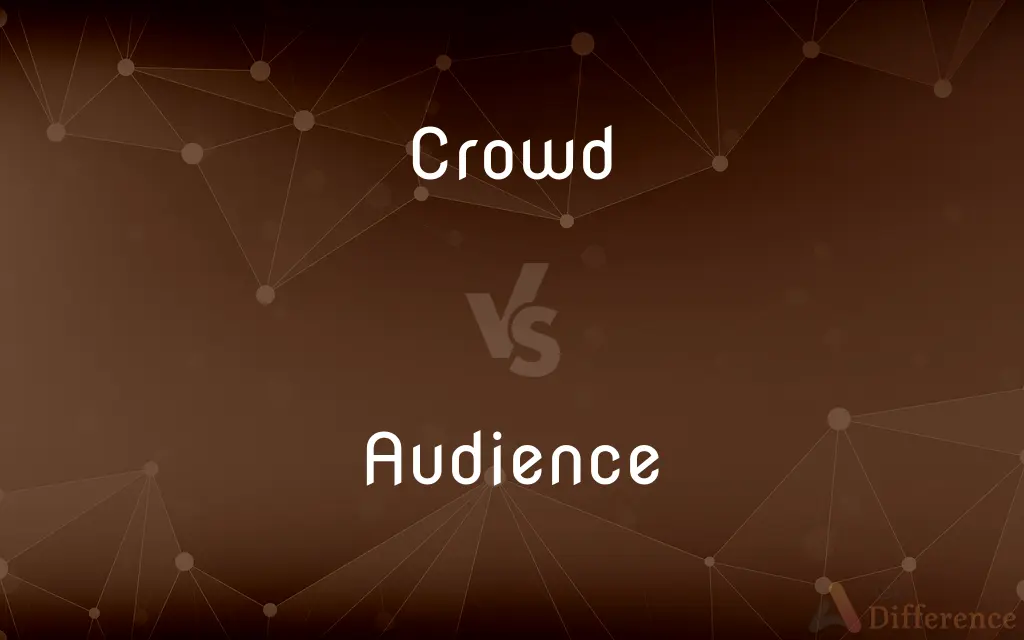Crowd vs. Audience — What's the Difference?
By Fiza Rafique & Urooj Arif — Updated on February 27, 2024
A crowd is a large group of people gathered, while an audience specifically gathers to observe a performance or event.

Difference Between Crowd and Audience
Table of Contents
ADVERTISEMENT
Key Differences
A crowd refers to any large group of people assembled together, regardless of the purpose. This gathering can be for various reasons such as events, demonstrations, or even spontaneous occurrences in public places. Crowds are characterized by their size and the physical presence of individuals in a specific location, without implying a common focus or intention beyond their gathering.
An audience, in contrast, is a group of people who come together with the intention of watching, listening to, or experiencing a performance, speech, movie, or any other form of entertainment or presentation. The key element that distinguishes an audience from a crowd is the purpose of their gathering, which is centered around observing or engaging with a specific event or performance.
A crowd can form for myriad reasons and may not have a specific shared interest, while an audience is unified in its focus on a particular event or performer. This distinction highlights the role of intent and engagement in defining the nature of a group's assembly.
Understanding the difference between a crowd and an audience is essential for planning, managing, and engaging with groups in various contexts, from event organization to public speaking and entertainment, ensuring the appropriate atmosphere and interactions are fostered.
Comparison Chart
Definition
A large group of people gathered together, regardless of purpose.
A group of people gathered to observe, listen, or engage with a performance or event.
ADVERTISEMENT
Purpose
Can be varied, including social, spontaneous, or event-driven reasons.
Specifically to watch, listen to, or experience a form of entertainment or presentation.
Focus
Not necessarily focused on a specific activity or event.
United in focus on a particular event, performance, or speaker.
Engagement
Engagement among individuals can be varied and not directed towards a common entity.
Engagement is directed towards the performance, presentation, or activity being observed.
Example Contexts
Protests, public gatherings, queues.
Theatre shows, concerts, lectures, movie screenings.
Compare with Definitions
Crowd
A large crowd gathered in the city square.
The crowd assembled for the New Year's Eve countdown.
Audience
An audience at a concert.
The audience cheered loudly as the band took the stage.
Crowd
Crowds in a shopping mall during sales.
The crowd surged on Black Friday.
Audience
Movie audience.
The movie audience gasped during the thriller's climax.
Crowd
Festival crowds.
Crowds roamed the festival grounds, enjoying various attractions.
Audience
Audience in a lecture hall.
The audience listened intently to the guest speaker.
Crowd
Crowds at a sports event.
Crowds filled the stadium to watch the football match.
Audience
Theatre audience.
The theatre audience gave a standing ovation at the end of the play.
Crowd
A crowd at a public demonstration.
A large crowd protested peacefully downtown.
Audience
Virtual audience for a webinar.
The virtual audience engaged with the presenter through comments and questions.
Crowd
Generally speaking, a crowd is defined as a group of people that have gathered for a common purpose or intent such as at a demonstration, a sports event, or during looting (this is known as an acting crowd), or may simply be made up of many people going about their business in a busy area. The term "the crowd" may sometimes refer to the lower orders of people in general.
Audience
An audience is a group of people who participate in a show or encounter a work of art, literature (in which they are called "readers"), theatre, music (in which they are called "listeners"), video games (in which they are called "players"), or academics in any medium. Audience members participate in different ways in different kinds of art; some events invite overt audience participation and others allowing only modest clapping and criticism and reception.
Crowd
A large number of persons gathered together; a throng.
Audience
The assembled spectators or listeners at a public event such as a play, film, concert, or meeting
He asked for questions from members of the audience
Crowd
A group of people attending a public function; an audience
The play drew a small but appreciative crowd.
Audience
A group of viewers or listeners, especially those present at a performance (as a play, concert, or lecture) or a public event (as a rally).
Crowd
A group of people congregated or collected into a close body without order.
After the movie let out, a crowd of people pushed through the exit doors.
Audience
Admittance to a hearing; a formal interview, esp. with a sovereign or the head of a government, for conference or the transaction of business.
According to the fair play of the world,Let me have audience: I am sent to speak.
Crowd
Several things collected or closely pressed together; also, some things adjacent to each other.
There was a crowd of toys pushed beneath the couch where the children were playing.
Audience
A gathering of spectators or listeners at a (usually public) performance;
The audience applauded
Someone in the audience began to cough
Crowd
A group of people united or at least characterised by a common interest.
That obscure author's fans were a nerdy crowd which hardly ever interacted before the Internet age.
We're concerned that our daughter has fallen in with a bad crowd.
Audience
The part of the general public interested in a source of information or entertainment;
Every artist needs an audience
The broadcast reached an audience of millions
Crowd
A number of things collected or closely pressed together; also, a number of things adjacent to each other.
A crowd of islands.
Crowd
A number of persons congregated or collected into a close body without order; a throng.
The crowd of Vanity Fair.
Crowds that stream from yawning doors.
Crowd
A large number of things or people considered together;
A crowd of insects assembled around the flowers
Common Curiosities
What distinguishes a crowd from an audience?
The main distinction is purpose; a crowd gathers for various reasons, while an audience gathers to engage with a performance or event.
Can a crowd become an audience?
Yes, if a crowd's focus shifts to a specific event or performance, it can become an audience.
Is an audience always smaller than a crowd?
Not necessarily; the size of an audience can vary widely and may be large or small, independent of the term "crowd."
Can an individual be part of a crowd and an audience simultaneously?
Yes, an individual in a crowd at a public event may also be part of an audience if focused on a specific performance or presentation within that event.
Can the behavior of a crowd and an audience differ?
Yes, crowd behavior can be unpredictable and varied, while audience behavior is typically more structured, guided by the context of the event.
What role does interaction play in defining a crowd or an audience?
Interaction among a crowd is generally dispersed and unrelated to a single focus, whereas audience interaction is often directed towards the performance or event.
How do organizers cater to crowds and audiences differently?
Organizers plan for crowd control and safety, while for audiences, they focus on engagement and experience related to the event.
What is the significance of audience feedback?
Audience feedback is crucial for performers and organizers to gauge the success of an event and make improvements.
What strategies are used to engage audiences during events?
Strategies include interactive elements, storytelling, multimedia presentations, and audience participation to enhance engagement.
How do digital platforms affect the concept of audiences?
Digital platforms expand the concept of audiences to include virtual gatherings, where people engage with content online.
What impact do social media have on crowds and audiences?
Social media can influence the formation, behavior, and engagement of both crowds and audiences, enhancing communication and interaction.
How does the setting affect the distinction between a crowd and an audience?
The setting can influence the behavior and purpose of the group; enclosed spaces typically house audiences, while open spaces can accommodate both crowds and audiences.
Why is crowd management important in public spaces?
Effective crowd management is essential for safety, preventing overcrowding, and ensuring orderly conduct in public spaces.
How do safety considerations differ between managing a crowd and an audience?
Safety for crowds involves managing large, potentially unpredictable gatherings, while audience safety focuses on structured environments like theaters or arenas.
How do cultural events bridge the gap between crowds and audiences?
Cultural events can transform a general crowd into a focused audience by providing a shared experience or performance.
Share Your Discovery

Previous Comparison
Scrod vs. Haddock
Next Comparison
Guesthouse vs. InnAuthor Spotlight
Written by
Fiza RafiqueFiza Rafique is a skilled content writer at AskDifference.com, where she meticulously refines and enhances written pieces. Drawing from her vast editorial expertise, Fiza ensures clarity, accuracy, and precision in every article. Passionate about language, she continually seeks to elevate the quality of content for readers worldwide.
Co-written by
Urooj ArifUrooj is a skilled content writer at Ask Difference, known for her exceptional ability to simplify complex topics into engaging and informative content. With a passion for research and a flair for clear, concise writing, she consistently delivers articles that resonate with our diverse audience.
















































